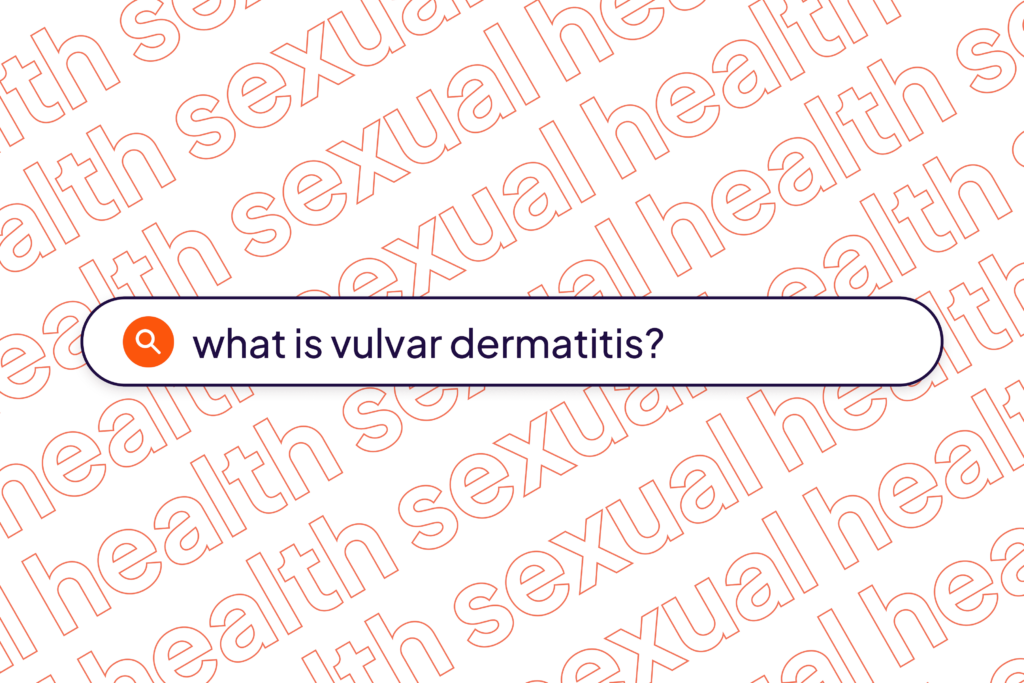:max_bytes(150000):strip_icc():format(jpeg)/Health-GettyImages-1682074275-3bcfe5eaf2094ec3b0f30cc98923a3c7.jpg)
Vulvar dermatitis is a skin condition that affects the skin of the vulva. The vulva is the external female genitalia, which includes the labia, clitoris, and vaginal opening.
People with vulvar dermatitis may experience redness, burning, itching, and irritation around the vulva. These symptoms may be mistaken for a sexually transmitted infection (STI); however, vulvar dermatitis is not contagious.
Vulvar dermatitis is often caused by irritants like scented soaps, sweat, heat, and friction from sanitary pads. Approximately 20-30% of people who seek medical attention for vulvar concerns have vulvar dermatitis.
There are three major types of vulvar dermatitis. Although the symptoms for all three are similar, the causes of each are somewhat different. The three types of vulvar dermatitis are:
Atopic Dermatitis
Atopic dermatitis—a type of eczema—is caused by a combination of genetic (inherited) and environmental factors. People with atopic dermatitis usually have a personal or family history of eczema, hay fever, or asthma.
Irritant Contact Dermatitis
This type of dermatitis develops when a skin irritant, such as friction from pads, tampons, condoms, or sweat, produces inflammation. Irritant contact dermatitis does not mean you are allergic to the irritant.
Allergic Contact Dermatitis
This type of dermatitis is caused by an allergic reaction to a substance around your vulvar area. It may occur due to an allergy to scented soaps or deodorants.
Dermatitis around the vulva can be uncomfortable, especially because the vulvar skin is sensitive. If you have vulvar dermatitis, you may experience the following symptoms around your vulva:
- Itching
- Burning
- Irritation
- Red, dry patches
- Scaling
- Cracking skin, sometimes with leaking fluid
- Blistering of the skin
- Stinging
Some of these symptoms may cause concern for STIs. It’s important to know that vulvar dermatitis is not a contagious condition. If you’re unsure what you’re dealing with, a healthcare provider can evaluate your skin and tell you if it’s vulvar dermatitis or something else.
Vulvar dermatitis is inflammation of the vulva’s skin. The skin provides an important barrier between the internal female genitalia and the environment. The skin may sometimes become irritated or inflamed, resulting in vulvar dermatitis symptoms.
There are different reasons why your vulva may become irritated or inflamed. What’s causing your skin’s irritation can depend on which type of vulvar dermatitis you have.
If you have atopic dermatitis, your genetics may play a role. People with atopic dermatitis are more likely to have a family history of allergic rhinitis (hay fever) and asthma. People with atopic dermatitis may also have issues with their skin’s ability to form a protective barrier, making them more susceptible to irritants.
For people with irritant or allergic contact dermatitis, their skin is reacting to an irritant, like friction from wearing pads, or an allergen, like fragrances.
Risk Factors
There are several risk factors that make you more likely to develop vulvar dermatitis. These factors include:
- Family history of hay fever, asthma, and atopic dermatitis
- Frequent sweating in the groin area
- Use of products that irritate the skin or prevent breathability of the area
If you’re experiencing symptoms of vulvar dermatitis, speaking with your healthcare provider is a great first step. They will likely ask about your medical history and examine the skin around your vulva.
Your healthcare provider can likely diagnose vulvar dermatitis based on your symptoms and the physical exam. They may also want to rule out other health conditions like yeast infections, other types of skin diseases, and STIs using additional tests.
If you have allergic contact dermatitis, your healthcare provider may perform tests to determine what you’re allergic to that’s causing the symptoms.
Vulvar dermatitis treatment mainly involves avoiding the irritant that’s causing symptoms. Potential irritants of vulvar dermatitis that you may want to avoid include:
- Frequent sweating in the groin area
- Shaving and waxing
- Tight-fitting clothing and underwear
- Hygiene products with scents, like deodorants
- Hygiene products such as wipes, pads, or tampons
- Certain lubricants and condoms
- Frequent douching or overwashing of the area
Besides a change in lifestyle or habits, other treatments available for vulvar dermatitis include allergy medications (antihistamines), moisturizers to improve the skin barrier, and anti-inflammatory medications.
The best way to prevent vulvar dermatitis symptoms is to reduce your exposure to common irritants associated with the condition. Some strategies include:
- Shower after exercise or swimming, and dry off completely
- Don’t shave or wax irritated skin
- Wear loose, breathable clothing
- Use unscented products
- Try different types of lubricants and condoms (such as latex-free)
- Avoid douching
If you have identified any specific allergies to products, avoiding those products will also help prevent vulvar dermatitis.
Scratching your vulva in an attempt to relieve itching can lead to complications. Scratching might wear off the top layer of your skin, and this skin damage can sometimes create an environment where a fungal or bacterial infection can develop. You may develop Staphylococcus aureus (staph), Streptococcus pyogenes, or Escherichia coli (E. coli).
If you repeatedly scratch the area, your vulvar skin may become thicker and feel like leather. This change is known as lichenification. Continued scratching can also make the folds of your labia appear swollen and make your pubic hair appear broken or thinly distributed.
Vulvar dermatitis is a non-contagious skin condition causing itching, redness, burning, and irritation around the vulva, often mistaken for infections.
It has three types: atopic dermatitis (linked to genetics and allergies), irritant contact dermatitis (caused by friction or sweat), and allergic contact dermatitis (triggered by allergens like scented soaps).
Diagnosis involves a physical exam and possibly allergy tests. Treatment focuses on identifying and avoiding irritants and making lifestyle changes.

